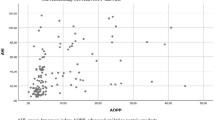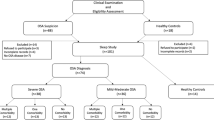Abstract
Purpose
We aimed to investigate whether systemic oxidative stress is increased in patients with obstructive sleep apnea syndrome (OSAS).
Methods
A total of 18 patients with severe OSAS and 13 controls were included in the study. Inclusion criteria for OSAS patients were: snoring and apnea–hypopnea index (AHI) of >30 in full polysomnography, no previous treatment for OSAS, non-smoking status, and a medical history of being free of comorbidities known to increase oxidative stress. Controls were recruited among subjects assessed for snoring in the Sleep Laboratory Department if they had AHI<5. At baseline, patients were evaluated by the Epworth Sleepiness Scale and underwent spirometry, echocardiography, and full polysomnographic study. Blood samples were collected for evaluation of oxidative stress biomarkers [protein carbonyls, reduced (GSH) and oxidized (GSSG) glutathione, 8-isoprostane, thiobarbituric acid-reactive substances (TBARS), catalase activity, Cu–Zn superoxide dysmutase (SOD), total antioxidant capacity (TAC)] before and on the morning following polysomnography.
Results
The overnight (morning–night) change (%) of GSH/GSSG ratio and GSH was significantly different between OSAS and controls (p = 0.03 and p = 0.048, respectively). Plasma protein carbonyls, erythrocyte catalase activity, 8-isoprostane, SOD, TBARS, and TAC plasma values were not different between OSAS and controls (p > 0.05). No significant correlation was found between changes in the levels of biomarkers and AHI, arousal, or desaturation index.
Conclusion
The present prospective investigation in a population free of comorbidities or factors which may increase systemic oxidative stress provides evidence that obstructive sleep apnea per se might be associated with increased oxidative burden possibly via GSH/GSSG pathway.

Similar content being viewed by others
Abbreviations
- AHI:
-
Apnea–hypopnea index
- AI:
-
Apnea index
- EF:
-
Ejection fraction
- FEV1:
-
Forced expiratory volume in the first minute
- FVC:
-
Forced vital capacity
- GSH:
-
Reduced glutathione
- GSSG:
-
Oxidized glutathione
- HDL:
-
High-density lipoprotein
- K2EDTA:
-
Dipotassiumethylenediaminetetraacetic acid
- LDL:
-
Low-density lipoprotein
- OSAS:
-
Obstructive sleep apnea syndrome
- PSM:
-
Polysomnography
- SaO2 :
-
Oxygen saturation
- SOD:
-
Cu–Zn superoxide dysmutase
- TAC:
-
Total antioxidant capacity
- TBARS:
-
Thiobarbituric acid-reactive substances
- TCA:
-
Trichloroacetic acid
- TG:
-
Triglycerides
References
Shamsuzzaman AS, Gersh BJ, Sommers VK (2003) Obstructive sleep apnea: implications for cardiac and vascular disease. JAMA 290:1906–1914
Lavie L (2003) Obstructive sleep apnoea syndrome: an oxidative stress disorder. Sleep Med Rev 7:35–51
Chung S, Yoon IY, Shin YK, Lee CH, Kim JW, Ahn HJ (2009) Endothelial dysfunction and inflammatory reactions of elderly and middle-aged men with obstructive sleep apnea syndrome. Sleep Breath 13:11–7
Quercioli A, Mach F, Montecucco F (2010) Inflammation accelerates atherosclerotic processes in obstructive sleep apnea syndrome (OSAS). Sleep Breath 14:261–9
Vatansever E, Surmen-Gur E, Ursavas A, Karadag M (2011) Obstructive sleep apnea causes oxidative damage to plasma lipid and proteins and decreases adiponectin levels. Sleep Breath 15:275–82
Htoo AK, Greenberg H, Tongia S, Chen G, Henderson T, Wilson D, Liu SF (2006) Activation of nuclear factor kappaB in obstructive sleep apnea: a pathway leading to systemic inflammation. Sleep Breath 10:43–50
Chung S, Yoon IY, Shin YK, Lee CH, Kim JW (2011) The effects of nasal continuous positive airway pressure on vascular functions and serum cardiovascular risk factors in obstructive sleep apnea syndrome. Sleep Breath 15:71–6
Oktay B, Akbal E, Firat H, Ardic S, Akdemir R, Kizilgun M (2008) Evaluation of the relationship between heart type fatty acid binding protein levels and the risk of cardiac damage in patients with obstructive sleep apnea syndrome. Sleep and Breath 12:223–8
Williams A, Scharf SM (2007) Obstructive sleep apnea, cardiovascular disease, and inflammation—is NF-kB the key? Sleep Breath 11:69–76
Carpagnano GE, Kharitonov SA, Resta O, Foschino-Barbaro MP, Gramiccioni E, Barnes PJ (2002) Increased 8-isoprostane and interleukin-6 in breath condensate of obstructive sleep apnea patients. Chest 122:1162–1167
Carpagnano GE, Kharitonov SA, Resta O, Foschino-Barbaro MP, Gramiccioni E, Barnes PJ (2003) 8-Isoprostane, a marker of oxidative stress, is increased in exhaled breath condensate of patients with obstructive sleep apnea after night and is reduced by continuous positive airway pressure therapy. Chest 124:1386–1392
Schulz R, Mahamoudi S, Hattar K, Sibelium U, Olschewski H, Mayer K, Seeger W, Grimminger F (2000) Enhanced release of superoxide from polymorphonuclear neutrophils in obstructive sleep apnea. Impact of continuous positive airway pressure therapy. Am J Respir Crit Care Med 162:566–570
Christou K, Markoulis N, Moulas AN, Pastaka C, Gourgoulianis KI (2003) Reactive oxygen metabolites (ROMS) as an index of oxidative stress in obstructive sleep apnea patients. Sleep Breath 7:105–10
Wali SO, Bahammam AS, Massaeli H, Pierce GN, Iliskovic N, Signal PK, Kryger MH (1998) Susceptibility of LDL to oxidative stress in obstructive sleep apnea. Sleep 21:290–296
Ozturk L, Mansour B, Yuskel M, Yalcin AS, Celicoglu F, Gokhan N (2003) Lipid peroxidation and osmotic fragility of red blood cells in sleep apnea patients. Clin Chim Acta 332:83–88
Muns G, Rubinstein I, Bergmann KC (1995) Phagocytocis and oxidative burst of blood phagocytes in chronic obstructive airway disease. Scand J Infect Dis 27:369–373
Svatikova A, Wolk R, Lerman L, Juncos L, Greene E, McConnell J, Somers V (2005) Oxidative stress in obstructive sleep apnoea. Eur Heart J 26:2435–2439
Nedeljkovic Z, Gokce N (2005) Effects of a maximal graded exercise test of glutathione as a marker of acute oxidative stress. J Cardpulm Rehabil 25:215–219
Patrono C, Fitz G (1997) Isoprostanes: potential markers of oxidant stress in atherothrombotic disease. Arterioscler Throm Vasc Bio 17:2309–15
Premamand R, Kumar S, Muhan A (2007) Study of TBARS and total reduced glutathione as indices of oxidative stress in chronic smokers with and without chronic obstructive pulmonary disease. Indian J Chest 49:9–12
Christou K, Kostikas K, Pastaka C, Tanou K, Antoniadou I, Gourgoulianis KI (2009) Nasal continuous positive airway pressure treatment reduces systemic oxidative stress in patients with severe obstructive sleep apnea syndrome. Sleep Med 10:87–94
Carskadon MA, Rechtschaffen A (2000) Monitoring and staging human sleep. In: Kryger MH, Roth T, Dement WC (eds) Principles and practice of sleep medicine, 3rd edn. Saunders, Philadelphia, pp 1197–1216
AASM Task Force (1999) Sleep-related breathing disorders in adults: recommendations for syndrome definition and measurement techniques in clinical research. Sleep 22:667–689
Guilleminault C (1992) Sleep disorders atlas task force. EEG arousals: snoring rules and examples. Sleep 15:173–184
Reddy Y, Murthy S, Krishna D, Prabhakar M (2004) Role of free radicals and antioxidants in tuberculosis patients. Indian J Tuberc 51:213–218
Tietze F (1969) Enzymic method for quantitative determination of nanogram amounts of total and oxidized glutathione: applications to mammalian blood and other tissues. Anal Biochem 27:502–522
Keles M, Taysi S, Sen N, Aksoy H, Akcay F (2001) Effect of corticosteroid therapy on serum and CSF malondialdehyde and antioxidant proteins in multiple sclerosis. Can J Neurol Sci 28:141–143
Patsoukis N, Zervoudakis G, Panagopoulos NT, Georgiou CD, Angelatou F, Matsokis NA (2004) Thiol redox state (TRS) and oxidative stress in the mouse hippocampus after pentylenetetrazol-induced epileptic seizure. NeurosciLett 357:83–86
Aebi H (1984) Catalase in vitro. Methods Enzymol 105:121–126
Janaszewska A, Bartosz G (2002) Assay of total antioxidant capacity: comparison of four methods as applied to human blood plasma. Scand J ClinLab Invest 62:231–236
Lang CA, Mills BJ, Mastropaolo W, Liu MC (2000) Blood glutathione decreases in chronic diseases. J Lab Clin Med 135:402–5
Lang CA, Mills BJ, Lang HL, Liu MC, Usui WM, Richie J Jr, Mastropaolo W, Murrell SA (2002) High blood glutathione levels accompany excellent physical and mental health in women ages 60 to 103 years. J Lab Clin Med 140:413–7
Nieto F, Young T, Lind B, Shahar E, Samet J, Redline S, D'Agostino RB, Newman AB, Lebowitz MD, Pickering TG (2000) Association of sleep-disordered breathing, sleep apnea, and hypertension in a large community-based study. Sleep Heart Health Study. JAMA 283:1829–1836
Peppard PE, Young T, Palta M, Skatrud J (2000) Prospective study of the association between sleep disordered breathing and hypertension. N Engl J Med 342:1378–1384
Barcelo A, Barbe F, De la Pena M, Vila M, Pérez G, Piérola J, Durán J, Agustí AG (2006) Antioxidant status in patients with sleep apnoea and impact of continuous positive airway pressure treatment. Eur Respir J 27:756–760
Dle-Donne I, Rossi R, Colombo R, Giustarini D, Milzani A (2006) Biomarkers of oxidative damage in human disease. Clin Chem 52:4
Grabska-Kobylecka I, Kobylecki A, Bialasiewicz P, Krol M, Ehteshamirad G, Kasielski M, Nowak P (2008) No evidence of enhanced oxidant production in blood obtained from patients with obstructive sleep apnea. J Negat Results BioMed 7:10
Dygovskaya L, Lavie P, Lavie L (2002) Increased adhesion molecules expression and production of reactive oxygen species in leucocytes of sleep apnea patients. Am J Respir Crit Care Med 165:934–9
Schulz R, Schmidt D, Blum A, Lopes-Ribeiro X, Lücke C, Mayer K, Olschewski H, Seeger W, Grimminger F (2000) Decreased plasma levels of nitric oxide derivatives in obstructive sleep apnoea: response to CPAP therapy. Thorax 55:1046–51
Urakawa II, Katsuki A, Sumida Y, Gabazza EC, Murashima S, Morioka K, Maruyama N, Kitagawa N, Tanaka T, Hori Y, Nakatani K, Yano Y, Adachi Y (2003) Oxidative stress is associated with adiposity and insulin resistance in men. J Clin Endocrinol Metab 88:4673–4676
Kirkham PA, Spooner G, Ffoulkes-Jones C, Calvez R (2003) Cigarette smoke triggers macrophage adhesion and activation: role of lipid peroxidation products and scavenger receptor. Free Radic Biol Med 35:697–710
Martin GM, Austad SN, Johnson TE (1996) Genetic analysis of ageing: role of oxidative damage and environmental stresses. Nat Genet 13:25–34
Rajagopalan S, Kurz S, Munzel T, Tarpey M, Freeman BA, Griendling KK, Harrison DG (1996) Angiotensin II-mediated hypertension in the rat increases vascular superoxide production via membrane NADH/NADPH oxidase activity: contribution to alterations of vasomotor tone. J Clin Invest 97:1916–1923
Inoue N, Kawashima S, Ilirata KI, Rikitake Y, Takeshita S, Yamochi W, Akita H, Yokoyama M (1998) Stretch force on vascular smooth muscle cells enhances oxidation of LDL via superoxide production. Am J Physiol 274:1928–1932
Cosentino F, Hishikawa K, Katusic ZS, Luscher TF (1997) High glucose increases nitric oxide synthase expression and superoxide anion generation in human aortic endothelial cells. Circ 96:25–28
Yamauchi M, Nakano H, Maekawa J, Okamoto Y, Ohnishi Y, Suzuki T, Kimura H (2005) Oxidative stress in obstructive sleep apnea. Chest 127:1674–1679
Alzoghaibi MA, Bahammam AS (2005) Lipid peroxides, superoxide dismutase and circulating IL-8 and GCP-2 in patients with severe obstructive sleep apnea: a pilot study. Sleep Breath 9:119–126
Pompella A, Visvikis A, Paolocchi A, De Tata V, Casini AF (2003) The changing faces of glutathione, a cellular protagonist. Biochem 66:1499–503
Pastore A, Piemonta F, Locatelli M, LoRusso A, Gaeta LM, Tozzi G, Federici G (2003) Determination of blood total, reduced and oxidized glutathione in pediatric subjects. Clin Chem 47:1467–1469
Mc Cord JM, Fridovich I (1988) Superoxide dismutase: the first twenty years. Free Radic Biol Med 5:363–9
Armstrong D, Browne R (1994) The analysis of free radicals, lipid peroxides, antioxidant enzymes and compounds to oxidative stress as applied to the clinical chemistry laboratory. Free Radic Diagn Med 366:43–58
Conflict of interest
The authors declare no conflict of interest.
Author information
Authors and Affiliations
Corresponding author
Additional information
Part of the results which are included in the present manuscript has been presented in the form of an abstract at the ERS Berlin 2008 Congress.
Electronic supplementary material
Below is the link to the electronic supplementary material.
ESM 1
(DOC 34 kb)
Rights and permissions
About this article
Cite this article
Ntalapascha, M., Makris, D., Kyparos, A. et al. Oxidative stress in patients with obstructive sleep apnea syndrome. Sleep Breath 17, 549–555 (2013). https://doi.org/10.1007/s11325-012-0718-y
Received:
Revised:
Accepted:
Published:
Issue Date:
DOI: https://doi.org/10.1007/s11325-012-0718-y




